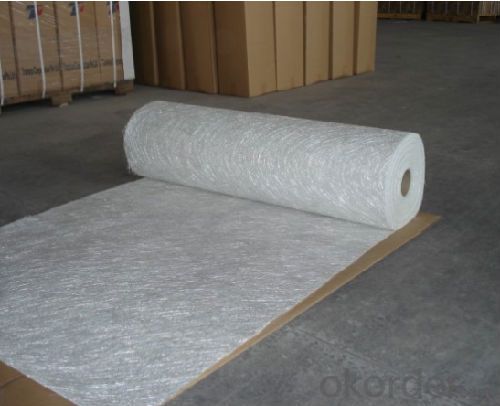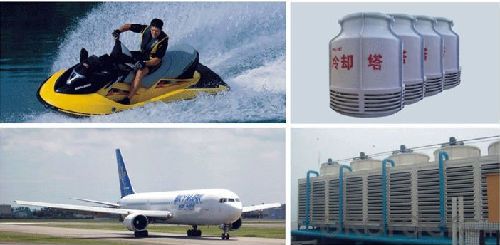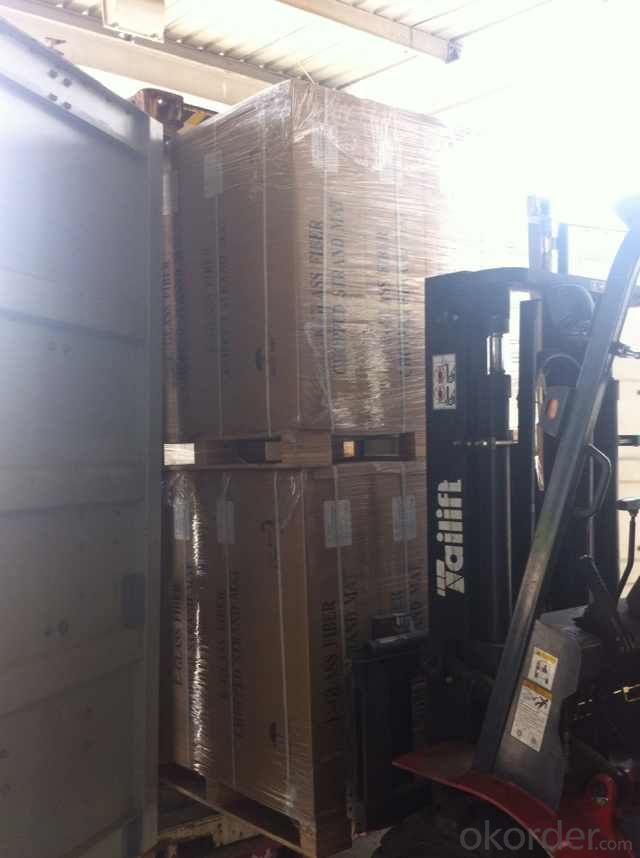E-glass CSM 450gsm 1040width with Best Price
- Loading Port:
- China Main Port
- Payment Terms:
- TT or LC
- Min Order Qty:
- 2000 kg
- Supply Capability:
- -
OKorder Service Pledge
OKorder Financial Service
You Might Also Like
Product Description
1.E-glass CSM 450gsm is made of randomly dispersed strands with power or emulsion bonded.
2.Applicable for hand lay-up ,continuous lamination process. Compatible with UP,VE.
3.Suitable for transparent panels,ship bodies,automobile parts and interior decorations ,etc.

Specifications:
E,C Specification | Weight g/m | Breaking strength N/150mm | Speed of impregnations | Package Weight (kg) |
E-MC100 | 100 | 30 | 60 | 20 |
E-MC200 | 200 | 30 | 180 | 30 |
E-MC350 | 300 | 43 | 180 | 30 |
E-MC450 | 450 | 60 | 180 | 30 |
E-MC600 | 600 | 80 | 180 | 30 |
Characteristics
1.Consistent thickness and stiffness.
2.Rapid impregnating and good compatibility with resin.
3.Superior wet through with less air trap.
4.Good mechanical properties and high strength of parts.
 Packaging&Storage
Packaging&Storage
Each roll is packed by polyester bag,and then put into a cardboard box or plastic wowen bag.The weight of each roll is between 20 to 85 Kg, The rolls are to be horizontally placed and could be in bulk or on pallet.Optimum storage conditions are between the temperature of 5~35℃ and with the humidity between 35%~65%.The product should be used within 12 months from the time of delivery and remain in theiroriginal packaging until just prior to use.
FAQ:
1.What is the delivery time ?
15days after receiving the deposit
2.Are you a trading company or factory.
We are factory,and we have more than 10 years of experience.

- Q:What is the typical lifespan of fiberglass fabrics?
- The typical lifespan of fiberglass fabrics can vary depending on various factors such as the quality of the fabric, the conditions it is exposed to, and how well it is maintained. However, on average, fiberglass fabrics can last anywhere from 10 to 30 years.
- Q:Can fiberglass fabric be used for insulation in oil and gas facilities?
- Yes, fiberglass fabric can be used for insulation in oil and gas facilities. It is a commonly used material due to its excellent thermal insulation properties, resistance to high temperatures, and durability in harsh environments. Additionally, fiberglass fabric is non-combustible and can help prevent heat transfer, making it suitable for insulating pipes, tanks, and equipment in oil and gas facilities.
- Q:Can fiberglass fabrics be used for insulation in HVAC systems?
- Indeed, insulation in HVAC systems can utilize fiberglass fabrics. The preference for fiberglass as an insulation material in HVAC systems stems from its exceptional thermal characteristics. Its low thermal conductivity enables it to effectively impede heat transfer. Fiberglass fabrics are typically employed to encase air ducts, pipes, and other components in HVAC systems to prevent heat loss or gain. Aside from its thermal efficiency, fiberglass fabrics possess other advantageous properties that render them suitable for insulation purposes. They are lightweight, flexible, and simple to install, making them a convenient option for HVAC insulation. Additionally, fiberglass fabrics exhibit resistance to moisture, mold, and mildew, thus contributing to the maintenance of satisfactory indoor air quality. Moreover, fiberglass fabrics boast outstanding fire-resistant qualities. They are non-combustible and do not emit toxic gases when exposed to high temperatures. Consequently, fiberglass fabrics constitute a safe choice for insulation in HVAC systems. All in all, the utilization of fiberglass fabrics for insulation in HVAC systems proves to be highly effective due to their thermal efficiency, ease of installation, resistance to moisture, and fire safety.
- Q:How does fiberglass fabric perform in abrasive environments?
- Fiberglass fabric performs exceptionally well in abrasive environments due to its high strength, durability, and resistance to wear and tear. The fabric's unique composition of glass fibers provides excellent resistance against abrasion, ensuring its longevity and performance even in harsh conditions.
- Q:What is the tensile strength of fiberglass fabric?
- The specific type and weave of fiberglass fabric determine its varying tensile strength. On average, fiberglass fabric possesses a tensile strength within the range of 3000 to 5000 pounds per square inch (psi). As a result, it boasts remarkable strength and durability, allowing it to withstand considerable levels of tension and stress without succumbing to breakage or tearing. Given its exceptional tensile strength, fiberglass fabric finds widespread use in numerous sectors including aerospace, automotive, construction, and marine industries.
- Q:Can fiberglass fabric be used for heat-resistant gloves?
- Indeed, heat-resistant gloves can utilize fiberglass fabric. Fiberglass possesses exceptional heat resistance characteristics, rendering it an optimal substance for gloves employed in high-temperature settings. This fabric exhibits the capacity to endure extreme heat without succumbing to ignition or melting. Moreover, fiberglass fabric boasts a lightweight and pliable nature, enabling comfortable usage while simultaneously providing defense against heat-related hazards. However, it is crucial to recognize that gloves constructed from fiberglass fabric may not be appropriate for handling open flames or direct contact with heated surfaces due to the material's potential for heat transfer via conduction. Consequently, it is advisable to opt for gloves specially designed for the intended heat application.
- Q:Can fiberglass fabric be used for heat-resistant aprons?
- Yes, fiberglass fabric can be used for heat-resistant aprons.
- Q:Can fiberglass fabric be dyed or printed on?
- Yes, fiberglass fabric can be dyed or printed on. However, it is important to use specific dyes and printing techniques suitable for fiberglass to ensure proper adhesion and durability of the color or print.
- Q:How does fiberglass fabric handle UV exposure?
- Fiberglass fabric boasts exceptional UV resistance, making it highly resistant to the sun's damaging ultraviolet rays. This is due to the intricate weaving of fine glass strands, which naturally possess this resistance. Consequently, fiberglass fabric can endure prolonged exposure to sunlight without suffering significant degradation or weakening. Typically, the glass fibers in fiberglass fabric receive an additional protective layer, such as a resin or polymer, further enhancing their UV resistance. This coating acts as a barrier, shielding the glass fibers from direct contact with UV rays and preventing any potential damage. Moreover, this coating helps maintain the fabric's strength and integrity over time, even when exposed to harsh sunlight. Given its UV resistance, fiberglass fabric finds widespread use in outdoor applications that involve exposure to sunlight. The construction industry, for instance, frequently employs it for roofing, insulation, and cladding, while the automotive sector relies on it for various exterior components. The fabric's ability to withstand UV exposure ensures its durability and longevity in these applications. However, it is worth noting that although fiberglass fabric is highly resistant to UV rays, it is not completely impervious to their effects. Prolonged and intense exposure to sunlight can eventually result in minor degradation, such as fading or discoloration. This is a natural process that occurs gradually and has minimal impact on the fabric's structural integrity or performance. To preserve the longevity of fiberglass fabric when exposed to UV rays, it is advisable to apply a protective coating or finish specifically designed for UV protection. Regular cleaning and maintenance can also help extend the fabric's lifespan and ensure its continued resistance to UV exposure.
- Q:Is fiberglass fabric resistant to chemicals used in wastewater treatment?
- Yes, fiberglass fabric is highly resistant to chemicals used in wastewater treatment. Fiberglass is known for its exceptional chemical resistance, making it an ideal material for applications where exposure to various chemicals is likely. It can withstand a wide range of corrosive substances, including acids, alkalis, and solvents, commonly found in wastewater treatment processes. The non-reactive nature of fiberglass fabric ensures that it does not degrade or deteriorate when exposed to these chemicals, making it a reliable choice for use in wastewater treatment facilities. Additionally, fiberglass fabric is also resistant to UV radiation, moisture, and temperature fluctuations, further enhancing its durability and suitability for such environments.
1. Manufacturer Overview |
|
|---|---|
| Location | |
| Year Established | |
| Annual Output Value | |
| Main Markets | |
| Company Certifications | |
2. Manufacturer Certificates |
|
|---|---|
| a) Certification Name | |
| Range | |
| Reference | |
| Validity Period | |
3. Manufacturer Capability |
|
|---|---|
| a)Trade Capacity | |
| Nearest Port | |
| Export Percentage | |
| No.of Employees in Trade Department | |
| Language Spoken: | |
| b)Factory Information | |
| Factory Size: | |
| No. of Production Lines | |
| Contract Manufacturing | |
| Product Price Range | |
Send your message to us
E-glass CSM 450gsm 1040width with Best Price
- Loading Port:
- China Main Port
- Payment Terms:
- TT or LC
- Min Order Qty:
- 2000 kg
- Supply Capability:
- -
OKorder Service Pledge
OKorder Financial Service
Similar products
New products
Hot products
Related keywords





























